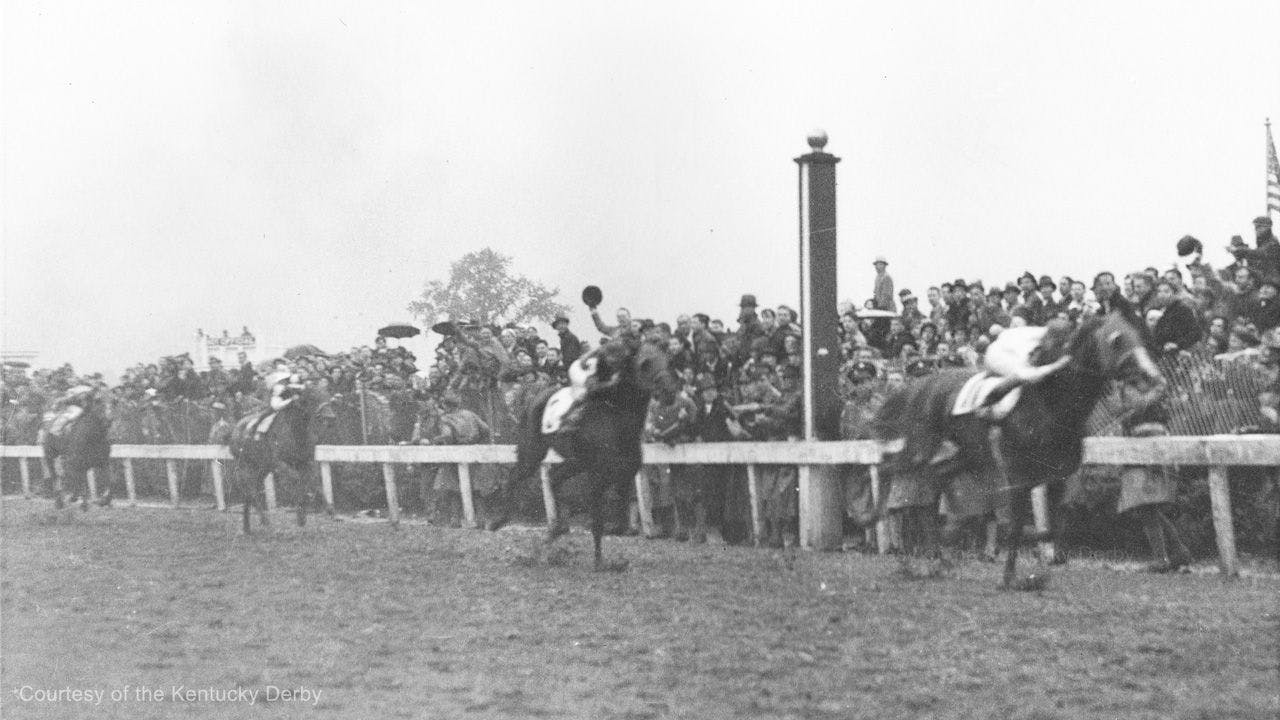Tall Tales of the Track, Kentucky Derby Edition: Nellie the First

Omaha wins the 1935 Kentucky Derby. (Courtesy of the Kentucky Derby/Churchill Downs)
The devil red and blue silks of Calumet Farm were familiar sights under the Twin Spires in the mid-20th century. These colors graced a record eight Kentucky Derby winners, including Whirlaway and Citation. Their decades of domination made them an institution in the sport, but even this influential owner had to start somewhere.
As Warren Wright transitioned Calumet from trotters to Thoroughbreds, he invested in a band of broodmares to create the families that would eventually produce two Triple Crown winners.
To build that program, he purchased a mare with classic credentials and a unique story of her own, one that combines a tobacco farm, a cartoonist, and the 20th century’s greatest horse to create Calumet’s first Kentucky Derby starter, a filly named Nellie Flag.
RELATED: Kentucky Derby Workout Videos
A Winning Mother
Her story begins not on luxurious green pastures, but on a Kentucky tobacco farm. Her granddam La Venganza had once been part of James Ben Ali Haggin’s broodmare band at Elmendorf Farm. Breeder Jack Keene, whose Keeneland Farm would eventually become the famed racetrack of the same name, had purchased the mare from Haggin’s dispersal sale, and then paired her with his farm’s resident stallion Luke McLuke, the 1914 Belmont Stakes winner.
Keene returned a few months later to find that La Venganza had foaled a bay filly on a farm strewn with dangerous equipment, wholly unsuitable for raising a racehorse. He insisted on keeping the young filly in a barn until she was weaned and later sent her to the 1922 Saratoga yearling sale, unconvinced that a horse raised in that environment would turn out to be anything notable. The gavel fell at $2,000 for La Venganza’s filly, sold to cartoonist Harry Conway “Bud” Fisher.
Famed for the "Mutt and Jeff" comics, Fisher’s fortune came from the syndicated newspaper comics and film shorts he produced. His fortune allowed him to invest in a racing stable, buying horses like La Verganza’s filly, whom Fisher would name Nellie Morse after his mother. In May 1924, Nellie Morse had a week to remember. First, she won the Druid Hill Purse on May 3 and then the Pimlico Oaks five days later. On May 12, she would make history.
The lone filly in a field of 15, Nellie Morse handled the slushy Pimlico racetrack to go wire to wire and win the Preakness Stakes by 1 1/2 lengths. With that victory, she became the fourth filly to win the classic stakes and the last one to do so for 85 years. The Preakness would be her last victory; she would finish third in the Kentucky Oaks and then placed second after the winner Glide was disqualified. Nellie Morse raced for one more season and then retired to broodmare life at Brookdale Farm near Lexington.
RELATED: Road to the Kentucky Derby
A Foundation Daughter
In late 1931, Fisher decided to sell his breeding stock, including his Preakness winner Nellie Morse. In foal to American Flag, a son of Man o’ War and winner of the 1925 Belmont Stakes, the mare was sold for $6,100 to Warren Wright, the new owner of Calumet Farm. Wright had inherited his father’s baking powder company and his Standardbred farm but had no interest in harness racing, selling his father’s Standardbreds in favor of building a Thoroughbred nursery. His purchase of Nellie Morse and her future American Flag foal would pay dividends for his fledgling stable. On February 25, 1932, the Preakness winner foaled a chestnut filly that Wright would name for both sire and dam, Nellie Flag.
The daughter of Triple Crown classic winners, splashed with a diagonal slant of white down her face, possessed speed and a smooth stride that carried her to victories in the Selima Stakes at Laurel, the Matron at Belmont Park, and the Kentucky Jockey Club at Churchill Downs, the latter against a field of eight colts. Her record of 10-5-3-0 in her two-year-old season made Nellie Flag one of the favorites for the 1935 Kentucky Derby, especially after winning the Cherokee Park Purse on April 27, a week before the Run for the Roses.
RELATED: Kentucky Derby Future Wagers
With early favorites like Chance Sun and Balladier out of the picture, the 61st Kentucky Derby was a wide-open affair, attracting a field of 18, including Today, Wood Memorial winner; Omaha, son of Triple Crown winner Gallant Fox; and the filly. Her stablemate Calumet Dick scratched, so the chestnut daughter of a Preakness and Belmont winner went to the post in the Kentucky Derby as the first horse to represent the fledgling Calumet Farm. Into her saddle trainer Bert Williams boosted a young Eddie Arcaro for his first Kentucky Derby.
The crowded field meant that the filly ran into traffic around the first turn and into the backstretch. By the time she had a clear path, the best she could manage was fourth behind Omaha. She followed her turn under the Twin Spires with a try at the Preakness Stakes, the same race her dam won. At Pimlico, she became the first to represent Calumet Farm in the middle jewel of the Triple Crown and the first mount for Eddie Arcaro, who would go on to win six Preaknesses in his 30-year career.
Though the roses were not hers in 1935, Nellie Flag made history for the devil red and blue silks of Calumet Farm as the first horse to wear those classic colors in the country’s most famous race. The combination of classic winners and the 20th century’s greatest horse produced a filly who not only represented her famed owner under the Twin Spires but also became a foundation mare for Calumet, producing a Kentucky Oaks winner and a line of horses that would one day produce another Kentucky Derby winner as well.



